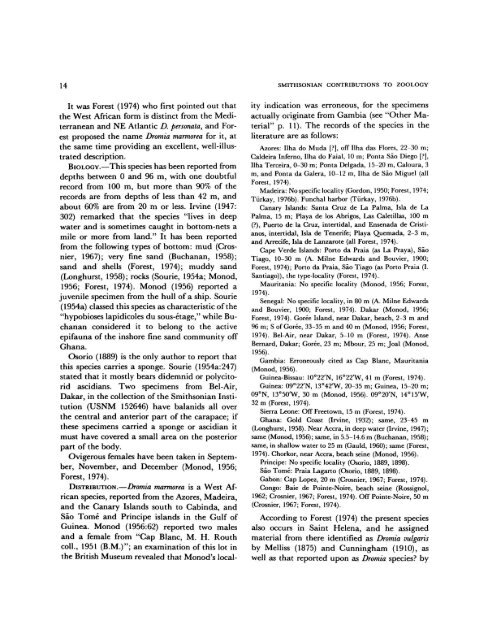West African Brachyuran Crabs - Smithsonian Institution Libraries
West African Brachyuran Crabs - Smithsonian Institution Libraries
West African Brachyuran Crabs - Smithsonian Institution Libraries
Create successful ePaper yourself
Turn your PDF publications into a flip-book with our unique Google optimized e-Paper software.
14<br />
It was Forest (1974) who first pointed out that<br />
the <strong>West</strong> <strong>African</strong> form is distinct from the Mediterranean<br />
and NE Atlantic D. personata, and Forest<br />
proposed the name Dromia marmorea for it, at<br />
the same time providing an excellent, well-illustrated<br />
description.<br />
BIOLOGY.—This species has been reported from<br />
depths between 0 and 96 m, with one doubtful<br />
record from 100 m, but more than 90% of the<br />
records are from depths of less than 42 m, and<br />
about 60% are from 20 m or less. Irvine (1947:<br />
302) remarked that the species "lives in deep<br />
water and is sometimes caught in bottom-nets a<br />
mile or more from land." It has been reported<br />
from the following types of bottom: mud (Crosnier,<br />
1967); very fine sand (Buchanan, 1958);<br />
sand and shells (Forest, 1974); muddy sand<br />
(Longhurst, 1958); rocks (Sourie, 1954a; Monod,<br />
1956; Forest, 1974). Monod (1956) reported a<br />
juvenile specimen from the hull of a ship. Sourie<br />
(1954a) classed this species as characteristic of the<br />
"hypobioses lapidicoles du sous-etage," while Buchanan<br />
considered it to belong to the active<br />
epifauna of the inshore fine sand community off<br />
Ghana.<br />
Osorio (1889) is the only author to report that<br />
this species carries a sponge. Sourie (1954a: 247)<br />
stated that it mostly bears didemnid or polycitorid<br />
ascidians. Two specimens from Bel-Air,<br />
Dakar, in the collection of the <strong>Smithsonian</strong> <strong>Institution</strong><br />
(USNM 152646) have balanids all over<br />
the central and anterior part of the carapace; if<br />
these specimens carried a sponge or ascidian it<br />
must have covered a small area on the posterior<br />
part of the body.<br />
Ovigerous females have been taken in September,<br />
November, and December (Monod, 1956;<br />
Forest, 1974).<br />
DISTRIBUTION.—Dromia marmorea is a <strong>West</strong> <strong>African</strong><br />
species, reported from the Azores, Madeira,<br />
and the Canary Islands south to Cabinda, and<br />
Sao Tome and Principe islands in the Gulf of<br />
Guinea. Monod (1956:62) reported two males<br />
and a female from "Cap Blanc, M. H. Routh<br />
coll., 1951 (B.M.)"; an examination of this lot in<br />
the British Museum revealed that Monod's local-<br />
SMITHSONIAN CONTRIBUTIONS TO ZOOLOGY<br />
ity indication was erroneous, for the specimens<br />
actually originate from Gambia (see "Other Material"<br />
p. 11). The records of the species in the<br />
literature are as follows:<br />
Azores: Ilha do Muda [?], off Ilha das Flores, 22-30 m;<br />
Caldeira Inferno, Ilha do Faial, 10 m; Ponta Sao Diego [?],<br />
Ilha Terceira, 0-30 m; Ponta Delgada, 15-20 m, Caloura, 3<br />
m, and Ponta da Galera, 10-12 m, Ilha de Sao Miguel (all<br />
Forest, 1974).<br />
Madeira: No specific locality (Gordon, 1950; Forest, 1974;<br />
Tiirkay, 1976b). Funchal harbor (Tiirkay, 1976b).<br />
Canary Islands: Santa Cruz de La Palma, Isla de La<br />
Palma, 15 m; Playa de los Abrigos, Las Caletillas, 100 m<br />
(?), Puerto de la Cruz, intertidal, and Ensenada de Cristianos,<br />
intertidal, Isla de Tenerife; Playa Quemada, 2-3 m,<br />
and Arrecife, Isla de Lanzarote (all Forest, 1974).<br />
Cape Verde Islands: Porto da Praia (as La Praya), Sao<br />
Tiago, 10-30 m (A. Milne Edwards and Bouvier, 1900;<br />
Forest, 1974); Porto da Praia, Sao Tiago (as Porto Praia (I.<br />
Santiago)), the type-locality (Forest, 1974).<br />
Mauritania: No specific locality (Monod, 1956; Forest,<br />
1974).<br />
Senegal: No specific locality, in 80 m (A. Milne Edwards<br />
and Bouvier, 1900; Forest, 1974). Dakar (Monod, 1956;<br />
Forest, 1974). Goree Island, near Dakar, beach, 2-3 m and<br />
96 m; S of Goree, 33-35 m and 40 m (Monod, 1956; Forest,<br />
1974). Bel-Air, near Dakar, 5-10 m (Forest, 1974). Anse<br />
Bernard, Dakar; Goree, 23 m; Mbour, 25 m; Joal (Monod,<br />
1956).<br />
Gambia: Erroneously cited as Cap Blanc, Mauritania<br />
(Monod, 1956).<br />
Guinea-Bissau: 10°22'N, 16°22'W, 41 m (Forest, 1974).<br />
Guinea: 09°22'N, 13°42'W, 20-35 m; Guinea, 15-20 m;<br />
09°N, 13°50'W, 30 m (Monod, 1956). 09°20'N, 14°15'W,<br />
32 m (Forest, 1974).<br />
Sierra Leone: Off Freetown, 15 m (Forest, 1974).<br />
Ghana: Gold Coast (Irvine, 1932); same, 23-45 m<br />
(Longhurst, 1958). Near Accra, in deep water (Irvine, 1947);<br />
same (Monod, 1956); same, in 5.5-14.6 m (Buchanan, 1958);<br />
same, in shallow water to 25 m (Gauld, 1960); same (Forest,<br />
1974). Chorkor, near Accra, beach seine (Monod, 1956).<br />
Principe: No specific locality (Osorio, 1889, 1898).<br />
Sao Tome: Praia Lagarto (Osorio, 1889, 1898).<br />
Gabon: Cap Lopez, 20 m (Crosnier, 1967; Forest, 1974).<br />
Congo: Baie de Pointe-Noire, beach seine (Rossignol,<br />
1962; Crosnier, 1967; Forest, 1974). Off Pointe-Noire, 50 m<br />
(Crosnier, 1967; Forest, 1974).<br />
According to Forest (1974) the present species<br />
also occurs in Saint Helena, and he assigned<br />
material from there identified as Dromia vulgaris<br />
by Melliss (1875) and Cunningham (1910), as<br />
well as that reported upon as Dromia species? by

















